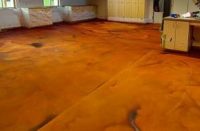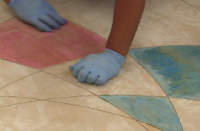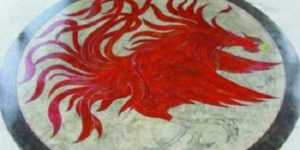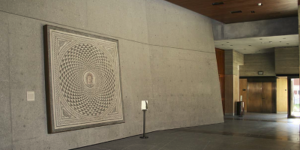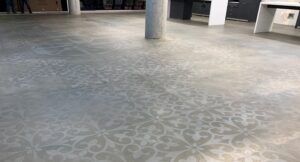When EnnisArt was contacted to install a map of the Connecticut River Watershed for the Hitchcock Center for the Environment in Amherst, Massachusetts, it was up for the challenge — specifically the Living Building Challenge. Based in Asheville, North Carolina, EnnisArt specializes in custom concrete flooring and concrete innovation, with a penchant toward artistic projects that maintain a green focus.
The Hitchcock educational center is made with building products which conform to stringent qualifications that meet the Living Building Challenge, by and large the most rigorous standard for green building. “Some have dubbed it ‘LEED on steroids,’” says Daniel de Wit, design associate, who together with his boss, Tom Schulz, created the map and densified and sealed 4,500 square feet of floors throughout the building.
They ended up exclusively using Prosoco Consolideck products because the colors, densifier and sealer had already been vetted to meet LBC criteria and were free of any chemicals on LBC’s “red list.” The products carry a Declare label, which is likened to a food’s ‘nutrition-label’ that lists all ingredients.
“The Living Building Challenge, with its emphasis on beauty, connection to place and elimination of chemicals of concern, is a perfect fit for Prosoco,” says Dwayne Fuhlhage, sustainability and environment director. “Our use of the Declare label is an extension of collaboration with leading design teams in our mutual journey towards constructing better buildings that are made to last and designed with future climate challenges in mind.”
The map, which is in a passageway that connects two larger parts of the building, is designed to give visitors a sense of a larger picture of the river’s watershed through a blend of art and cartography. The center’s rain water filtration and storage tanks are housed in the large hallway in flush tanks for all to see: a small-scale watershed that mimics the Connecticut River ecosystem. The center’s salamander logo marks the building’s location on the map.
The map’s design was derived from a combination of Google Earth maps and historic maps and images, de Wit says, to make an architectural blueprint. Schulz painted a watercolor that de Wit photographed and placed inside the blueprint, which was then hand-drawn on the floor using a scaled grid. To get a layered, mottled and 3-D effect, Schulz hand-painted the river’s edges and sprayed 12 Consolideck ColorHard hues in various dilutions and patterns.
Schulz and de Wit also installed deer and coyote tracks as a wayfinding system that runs from the classrooms to the bathroom in a realistic pattern that looks like the coyote is chasing the deer. “The Hitchcock Center’s summer youth program toured the site and one of the children thought a coyote had actually run through the building,” de Wit says. “That’s how realistic they ended up looking.”
www.ennisart.net
www.hitchcockcenter.org
www.living-future.org/lbc
www.prosoco.com
